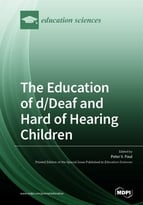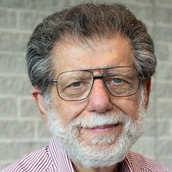The Education of d/Deaf and Hard of Hearing Children: Perspectives on Language and Literacy Development
A special issue of Education Sciences (ISSN 2227-7102).
Deadline for manuscript submissions: closed (30 April 2019) | Viewed by 84299
Special Issue Editor
Interests: education of d/Deaf and hard of hearing students; language development; literacy development
Special Issues, Collections and Topics in MDPI journals
Special Issue Information
Dear Colleagues,
Historically, the development of English language and literacy has been one of the most contentious issues in the education of children and adolescents who are d/Deaf and hard of hearing (d/Dhh). This development has continued to challenge theorists, researchers, and educators because a number of d/Dhh students not only do not read or write as well as their typical literacy peers, but also they may not even reach a level of functional English literacy upon graduation from compulsory education (i.e., high school). The complexity of this development has increased in light of the growing number of minorities, including immigrants, in the United States, particularly the growth of d/Dhh students whose home language is not English—that is, English language learners. There is ongoing disputatious debate on the interpretation of the role and research findings associated with the use of assistive hearing technology (e.g., digital hearing aids, cochlear implants). There is also a need to address the development of language and literacy in d/Dhh individuals with disabilities or additional disabilities—the so-called “deaf plus” cohort.
Using either a professional review or a meta-analysis format, this Special Issue provides a state-of-the-art rendition of the development of language and literacy in d/Dhh children and adolescents. Although this is not an exhaustive exploration of all areas, it is hoped that the Issue has covered the most salient domains. The focus is on d/Dhh individuals; however, there may be a need to discuss the use of findings from the larger field of literacy (i.e., on typical literacy learners) due to the dearth of evidence-based research results for d/Dhh individuals.
There are ten articles with the following titles and descriptions:
- Language and Literacy: Issues and Considerations
This article provides background on the major perspectives involving the development of English language and literacy with respect to the evolving demography of d/Dhh children and adolescents. It synthesizes research and controversies on the developmental similarity hypothesis—that is, whether the acquisition of English language and literacy of d/Dhh students is developmentally similar to that of typical language/literacy learners. The outcomes of this discussion have instructional implications and proffer guidelines for teacher preparation programs. The article concludes with directions for further research.
- Language Development
The development of “through-the-air” language proficiency is examined with a focus on the relation of language to the acquisition of English literacy. With the focus on language development, the article synthesizes the findings of evidence-based research and practices. This synthesis covers not only language instruction/intervention, but also the current findings re the use of the various communication systems associated with English (e.g., sign systems, oral English approaches, cued speech/language). The article concludes with recommendations for further research.
- English Reading Development
This article focuses on the development of English reading at two broad timeframes—emergent and conventional. Emergent reading/literacy is concerned with early development and conventional literacy refers to mature or later development. The article synthesizes research on the fundamentals for developing early reading skills and for maintaining reading throughout the school years. In addition to providing a synthesis of evidence-based research and practices, the article concludes with recommendations for further research.
- English Writing Development
This article focuses on the development of English writing at two broad timeframes—emergent and conventional. The article synthesizes evidence-based research on the fundamentals for developing early writing and conventional writing skills; albeit, there has not been much research on writing and d/Deaf and hard of hearing children. Also discuss is the relationship between reading and writing. The article concludes with recommendations for further research.
- English Language Learners
If English is not the home language, then it is imperative to explore the merits of bilingual and second-language programs for d/Dhh individuals. The use of a signed language in the education of d/Dhh children has engendered debates on the rights of d/Dhh individuals to develop a native language and to have unlimited access to information. Much of the focus has been on the use of American Sign Language (ASL) as the language of instruction for developing English as a second (or third) language. There has been some recent debate on the merits of creating a written form of ASL to facilitate the second-language and literacy development of English. The article synthesizes evidence-based research and practices and proffers recommendations for further research.
- Deaf “Plus” Learners
Estimates of individuals who are d/Dhh and who possess either a disability or an additional disability (e.g., cognitive disability) range from about 30% to more than 50%. There is also the challenge of enumerating and addressing the needs of individuals who are deaf-blind with or without accompanying additional disabilities. Even the nature of the “additional disability” (i.e., beyond deafness and/or blindness) is not always clear, given the limitations of our current state of assessment. This article synthesis the available research on the development of language and literacy in this sub-population. The article concludes with recommendations for further research.
- Assistive Hearing Technology
There is little doubt that advances in technology have altered the demographic landscape of children and adolescents with a wide range of hearing acuity/loss. In one sense, as a result of technology, our thinking has evolved on what it means to be human. This article synthesizes the research on cochlear implants and other assistive hearing technology (notably digital hearing aids) on the development of language and literacy in d/Dhh students. There is a discussion of the design of studies, which may have contributed to equivocal findings. The article concludes with recommendations for further research.
- Assessment Issues
This article covers current assessment models; that is, the manner in which language and literacy are evaluated. With respect to children and adolescents who are d/Deaf and hard of hearing, it is important to discuss concerns such as cultural relevancy, accommodations, and what makes a test appropriate or inappropriate. Also discussed are the challenges of assessing d/Dhh students who are English language learners. The article concludes with recommendations for further research.
- Inclusion and Language/Literacy Achievement
There has been much debate on the effects of educational environment, a global entity, on academic achievement. One of the most controversial issues is the merits of inclusion. This article synthesizes the research on inclusion and the development of language and literacy skills in d/Dhh children and adolescents. The article concludes with recommendations for further research.
- Conclusion: What Now, What Next, Where To?
This concluding article provide final reflections and direction for further dialogue and inquiry on the various controversial topics discussed in this Special Issue. The article will comment on the contributors’ conclusions and recommendations for further research.
Prof. Peter V. Paul
Guest Editor
Manuscript Submission Information
Manuscripts should be submitted online at www.mdpi.com by registering and logging in to this website. Once you are registered, click here to go to the submission form. Manuscripts can be submitted until the deadline. All submissions that pass pre-check are peer-reviewed. Accepted papers will be published continuously in the journal (as soon as accepted) and will be listed together on the special issue website. Research articles, review articles as well as short communications are invited. For planned papers, a title and short abstract (about 100 words) can be sent to the Editorial Office for announcement on this website.
Submitted manuscripts should not have been published previously, nor be under consideration for publication elsewhere (except conference proceedings papers). All manuscripts are thoroughly refereed through a double-blind peer-review process. A guide for authors and other relevant information for submission of manuscripts is available on the Instructions for Authors page. Education Sciences is an international peer-reviewed open access monthly journal published by MDPI.
Please visit the Instructions for Authors page before submitting a manuscript. The Article Processing Charge (APC) for publication in this open access journal is 1800 CHF (Swiss Francs). Submitted papers should be well formatted and use good English. Authors may use MDPI's English editing service prior to publication or during author revisions.
Keywords
- assessment
- assistive hearing technology
- d/Deaf and hard of hearing children
- deaf “Plus” learners
- inclusion
- language development
- literacy development






